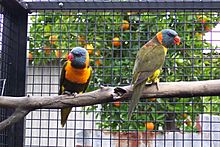Red-collared lorikeet facts for kids
Quick facts for kids Rainbow lorikeet |
|
|---|---|
 |
|
| Red-collared lorikeets of the olive mutation, which is overall far duller than the "natural" form | |
| Conservation status | |
| Scientific classification | |
| Kingdom: | |
| Class: | |
| Order: | |
| Family: | |
| Subfamily: | |
| Genus: |
Trichoglossus
|
| Binomial name | |
| Trichoglossus rubritorquis (Linnaeus, 1771)
|
|
The red-collared lorikeet (Trichoglossus rubritorquis) is a species of lorikeet. It was a subspecies of the rainbow lorikeet, but now they are regarded as separate species. The bird is found living in northern Australia.
Contents
Habitat
The red-collared lorikeet is found in Northern Australia, as far west as Broome, Western Australia, right through the Kimberley region, across the top of the Northern Territory to the bottom of the Cape York Peninsula.
Description
It is about 305 mm (12 in) long with brightly colored feathers. It is the largest of the Australian lorikeets. The head and the face are blue, and it has an orange to red chest which narrows to a thin colored band around the neck, like a collar. Its wings and tail are green, with some yellow tips on the feathers. The feathers on its abdomen are dark blue to black. It has a red beak, and grey to brown legs and feet. The female is the same as the male but smaller. They can live up to 15 years.
How they live
The bird is nomadic and moves about in large flocks. They feed on eucalyptus flowers, as well as nectar from other flowering plants such as grevilleas, and seeds from grass trees. It is described as being a restless and noisy bird, making a shrill shrieking noise when flying.
Breeding
It builds nests in hollows in eucalyptus trees, usually near a creek. They lay two dull white eggs in the breeding season from August and January or March to June or May to December.
See also
 In Spanish: Lori de cuello rojo para niños
In Spanish: Lori de cuello rojo para niños


